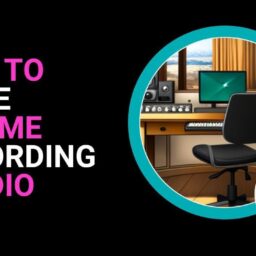Songwriting is one of the most fulfilling artistic pursuits.
It’s a chance to channel emotions, tell stories, and connect with listeners in a deeply personal way. Whether you’re writing your first song or looking to elevate your work to the next level, this comprehensive guide will provide you with the tools you need. From crafting lyrics to building melodies, structuring your song, and overcoming creative hurdles, we’re here to help spark your musical creativity.
Studying famous songs can provide valuable insights into successful songwriting techniques, such as the use of hooks and memorable melodies.
Take a deep breath, grab your favorite instrument or notebook, and let’s turn your ideas into music that resonates!
1. Getting Started
Every song starts with a spark, but sometimes it’s hard to ignite the flame. Here’s how to get those initial ideas flowing.
Begin with a Concept or Title
Great songs often hinge on captivating ideas or titles. Developing a strong foundation here will guide the rest of your process:
Tap into Your Feelings
Music is personal, and that’s its magic. Consider what you’re feeling at this moment: joy, heartbreak, nostalgia, excitement, and channel those emotions into your lyrics. Adele’s “Hello” is an anthem of longing, and its universal appeal lies in its emotional authenticity.
Ask yourself, “What emotion do I want my audience to feel?”
Exercise: Write down five emotions you’re experiencing right now. For each, come up with a short phrase describing how it feels. For example, if you’re feeling nostalgic, you might write, “Faded Polaroid memories.” Remember, don’t overly judge your own songs; maintain an open mind during the songwriting process to foster creativity and freedom.
Pick a Strong Title
Titles spark curiosity. For instance, “Smells Like Teen Spirit” by Nirvana grabs your attention even before the music starts. Experiment with vivid imagery, bold statements, or memorable phrases. Think beyond the obvious—titles that hint at deeper meaning often capture attention.
Try This: Write down five potential song titles in one minute. Choose the one that intrigues you the most and start brainstorming lyrics inspired by it.
Brainstorm Freely
Don’t censor your thoughts during this phase. Write down everything: raw ideas, fragments of lyrics, or just a list of words. Your first idea doesn’t have to be good; it’s just the starting point. Even something small, like a phrase that pops into your head during a morning walk, could grow into a beautifully layered song. Listening to other songs can also provide inspiration and guidance, helping you explore structures, melodies, and chord progressions that resonate with your creative vision.
Mind Map Exercise:
Take your title or concept and draw it in the center of a blank sheet of paper. Branch out keywords, moods, or related ideas that spring to mind. For example, for a concept like “freedom,” you might branch out to “open spaces,” “birds,” “unchained,” or “cloudless skies.”
Believe in Yourself
This might seem simple, but it’s essential. If you identify as a songwriter, you’ll be less afraid of mistakes and more willing to experiment. Even professionals write dozens (or hundreds) of songs before they find that one perfect hit. Confidence is your creative fuel.
2. Creating Your Song
Your song begins to take form as you write the lyrics and find their emotional core. Here’s how to approach it like a pro:
Write Lyrics from Experience and Inspiration
Tell Your Own Story
People connect deeply with authenticity. Think of Taylor Swift processing a breakup in “All Too Well” or Bruce Springsteen reflecting on blue-collar life in “The River.” However, your stories don’t have to be overwhelming or dramatic to resonate. Even simple, everyday moments can inspire moving songs when told honestly. Personal experience in song writing is crucial, as many successful songs are born out of real-life events and emotions.
Exercise: Reflect on a specific memory that matters to you: a childhood moment, a hard lesson, or even last week’s coffee shop encounter. Write about how it felt, then craft a few lines around that emotion.
Borrow from Observation or Imagination
Not every great song is autobiographical. Bob Dylan’s “The Times They Are A-Changin’” is observational, while David Bowie’s “Space Oddity” builds an imaginative narrative about a fictional astronaut. Look beyond your own life to capture universal emotions or invent stories that spark excitement. Experimenting with different melodies while composing music can also help you find the most resonant and unique sound.
Tip: Imagine a conversation between two characters or record snippets of dialogue you overhear. You never know how these could inspire lyrics.
Use Vivid Imagery
Paint pictures with your words. For instance, instead of simply saying “I’m sad,” evoke imagery like, “My shadow stayed while you walked away.” Powerful visuals stick in the listeners’ minds.
Play with Sound
Lyrics don’t need to be profound poetry all the time. Songs like “Umbrella” by Rihanna stand out due to playful repetition and sound—“ella-ella-eh-eh-eh” feels fun and memorable.
Challenge: Pick five descriptive words that relate to your song’s mood and experiment with ways you can work them into repetitive or meaningful phrases for a hook.
Keep Lyrics Memorable
When writing a chorus, simplicity is key. Repetition helps the audience connect to the message of your song quickly. Think about Queen’s “We Will Rock You”—its universal appeal comes down to its straightforward yet powerful lyrics and rhythm. Incorporating a powerful hook into the song structure is crucial, and the entire chorus can either represent the hook itself or be constructed around it, enhancing the overall impact of the song.
Test Your Lyrics: Sing your lyrics aloud. Do they feel smooth and catchy? Do they flow naturally to a beat? Refine them until they’re easy to hum and recall.
3. Building Your Song Structure
A clear structure helps guide the listener through your song. Start by considering common patterns and using them as a foundation.
Popular Structures
| Structure | What It Does |
|---|---|
| Verse – Chorus – Verse – Chorus | Alternates storytelling in verses with an emotional release in the chorus. |
| Verse – Bridge – Chorus – Outro | Introduces contrast and resolution for dynamics. |
| Verse – Pre-Chorus – Chorus | Builds anticipation before the chorus hits like a wave. |
Example in Action:
Take Avicii’s “Wake Me Up,” which uses verses to explore reflection, leading to an epic uplifting chorus.
Tips for Emotional Flow
- Start Strong: Use the intro to establish a tone that hooks the listener.
- Build Tension: Add pre-choruses or crescendos to lead to the emotional high point.
- Contrast Sections: Make the melody or chords in the chorus distinctly different from the verses.
Exercise: Choose one structure to practice. Fill in placeholders for “verse,” “chorus,” and “bridge” with basic ideas (e.g., Verse 1 = heartbreak, Chorus = resilience).
4. Creating a Memorable Melody
A melody is often what sticks with listeners first. A good melody feels inevitable—like it was waiting to be discovered.
Find the Magic in Simplicity
Sing It Out
Speak or hum your lyrics aloud with emotion. Does a melody emerge naturally, emphasizing certain words or phrases? This process often leads to an organic, singable tune.
Play with Variations
Once you’ve got your basic melody, tweak it. Test:
- Higher or lower pitch ranges
- Different tempo speeds
- Holding notes longer or breaking them into smaller parts
Experiment with a repeated chord pattern alongside various chord progressions to find a pleasing musical combination.
Example: Listen to how Ed Sheeran varies the melody across verses and choruses in “Thinking Out Loud.”
Add Layers with Harmony and Instrumentation
Complement your melody with harmonies, chords, or instrumental flourishes. Bands like Fleetwood Mac use harmonies masterfully to enhance emotional impact.
Exercise: Record your melody and experiment with harmonizing yourself in a free music app or free daw.
5. Developing Chord Progressions
Your chords are the foundation that supports your melody and mood.
- Start Simple: Use tried-and-tested patterns like I-V-vi-IV (C-G-Am-F) for emotional versatility.
- Match the Mood: Major keys for cheerful energy, minor keys for deeper emotions, and unexpected progressions for intrigue.
- Add Extensions: Include sevenths, diminished chords, or progressions like ii-V-I to inspire new directions.
Collaborating with other musicians can also provide fresh perspectives and ideas. The creative process involved in writing a new song can be challenging, with different approaches such as developing a melody or chorus first. There are no strict rules, and each songwriter may have their unique method for crafting a new song.
Feeling confused? Have a look at this post: Chord Progression Chats
Challenge: Pick your favorite pop or rock song and play its chords on piano or guitar. Analyze its structure, noticing how the chords influence the mood.
6. Collaborating with Other Musicians
Get Feedback and Improve Your Song
Collaborating with other musicians can be a game-changer in your songwriting journey. It’s an opportunity to gain fresh perspectives and refine your craft. When you work with a co-writer or producer, you open the door to new ideas and techniques that can elevate your song to new heights.
Benefits of Collaboration:
- New Insights and Ideas: Different minds bring different strengths. A collaborator might suggest a chord progression or lyrical concept you hadn’t considered.
- Learning from Experience: Working with seasoned musicians can teach you valuable lessons about song structure, melody, and more.
- Skill Development: Collaboration can push you out of your comfort zone, helping you develop new skills and styles.
- Polished Songs: Two heads are often better than one when it comes to creating a well-rounded, polished song.
- Networking: Building relationships with other musicians can open doors in the music industry.
Tips for Successful Collaboration:
- Clear Communication: Be open about your ideas and listen to your collaborator’s suggestions.
- Respect and Open-mindedness: Respect each other’s creative input and be willing to try new things.
- Set Goals and Expectations: Define what you want to achieve and establish a clear workflow.
- Compromise: Be willing to find a middle ground to create the best song possible.
By embracing collaboration, you can transform a good song into a hit song that resonates with listeners. Don’t be afraid to share your ideas and be open to feedback: it’s all part of the creative process.
7. Recording and Finalizing Your Song
Bring Your Song to Life
Recording and finalizing your song is where your hard work truly comes to life. This stage is all about capturing the essence and emotion of your music, ensuring it sounds as professional as possible.
Tips for Recording:
- Choose the Right Equipment and Software: Invest in quality recording equipment and software like Cubase, Ableton Live, Logic Pro X, Pro Tools, or GarageBand to capture the best sound.
- Plan Your Session: Organize your recording session, deciding the order of tracks and the equipment needed.
- Record Separately: Start with the rhythm section—drums and bass guitar—then layer guitars, keyboards, and vocals.
- Experiment: Don’t be afraid to try different sounds and techniques to add depth and interest to your song.
- Mix and Master: Once all tracks are recorded, mix and master your song to achieve a balanced, polished sound.
Finalizing Your Song:
- Take Your Time: Be patient and meticulous during the final stages.
- Objective Listening: Listen to your song with fresh ears and make the necessary adjustments.
- Seek Feedback: Get input from others to ensure your song is the best it can be.
- Share Your Creation: Be proud of your work and share it with the world.
By following these steps, you can create a professional-sounding track that showcases your talent and creativity, ready to captivate your audience.
Explore the top Digital Audio Workstations (DAWs) for Recording Vocals
6. Refine Your Song
Polishing the Lyrics
Revisit your lyrics with fresh ears. Does the rhyme fit naturally? Does the story make sense? Are there any redundant or awkward lines? Aim for lyrics that come alive in the listener’s mind when sung.
Proof Test: Share your lyrics with a trusted friend and ask them to summarize what they heard: this will show if your intent is coming through. Writing lyrics is a fundamental aspect of songwriting, and developing compelling lyrics can be achieved through collaboration and careful consideration of rhythm and structure.
Professional Tips for Refinement
- Take breaks between listening and editing. Fresh ears reveal a lot!
- Strip down the arrangement and rehearse with just a guitar or piano to focus on the song itself.
9. Getting Feedback and Support
Join a Songwriting Community
Joining a songwriting community can be incredibly beneficial for your growth as a songwriter. These communities offer valuable feedback, support, and motivation, helping you refine your craft and achieve your goals.
Benefits of a Songwriting Community:
- Feedback on Your Songs: Share your work and receive constructive criticism on your lyrics, verse melody, chorus melody, and overall song structure.
- Learn from Others: Gain insights from other songwriters’ experiences and techniques.
- Networking: Connect with other songwriters and industry professionals who can help advance your career.
- Stay Motivated: Surround yourself with like-minded individuals who share your passion for songwriting.
- Access Resources: Many communities offer workshops, contests, and gigs to help you grow.
Popular Songwriting Communities:
- Songwriting Organizations and Guilds: Join groups dedicated to supporting songwriters.
- Online Forums and Social Media Groups: Engage with other songwriters online.
- Local Meetups and Workshops: Participate in local events to connect with fellow songwriters.
- Music Schools and Colleges: Take advantage of resources and opportunities offered by educational institutions.
When joining a songwriting community, be open-minded, respectful, and willing to learn. Share your songs, ask for feedback, and offer constructive criticism to others. By engaging with a supportive community, you can take your songwriting to the next level and achieve your musical aspirations.
7. Overcoming Writer’s Block
Everyone hits a creative wall, but there are actionable ways to break through it:
- Free Write: Spend 10 minutes writing continuously about anything: no editing!
- Change Mediums: Play riffs on a guitar if you usually start with lyrics, or hum instead of strumming.
- Collaborate: Swap creative energy with a co-writer or friend for fresh input.
The process of writing a song can be both challenging and rewarding, highlighting the importance of creativity and organization.
Remember: Writer’s block is temporary, never permanent. Shake it off by trying something outside your usual routine.
8. Motivation and Persistence
Remember, everyone has their creative rhythm, so establish habits that keep you steadily moving forward. Set goals, listen to diverse music, and celebrate even your small wins.
Wrap-Up Challenge: Write one verse and chorus inspired by today’s mood. Whether you finish the song now or later, the goal is progress!
Suggested Reading
How to Copyright a Song: A Comprehensive Guide
Practice and Enjoy!





